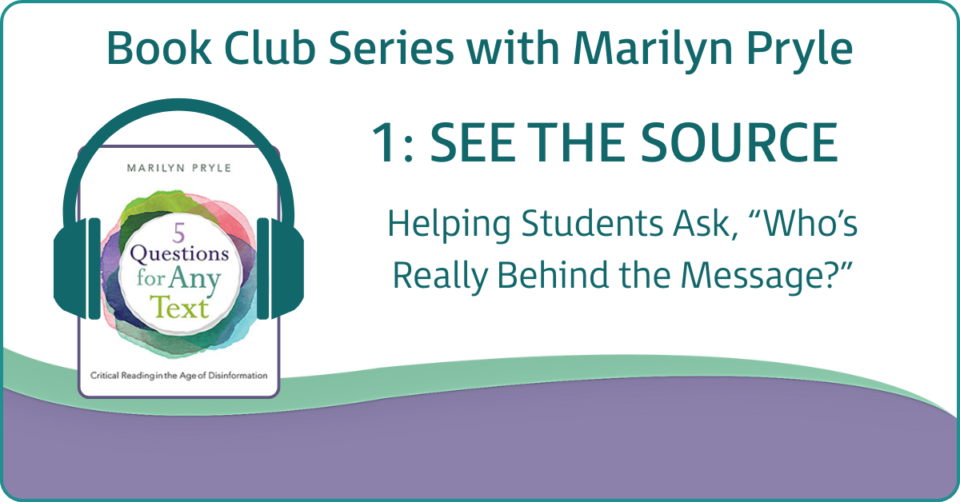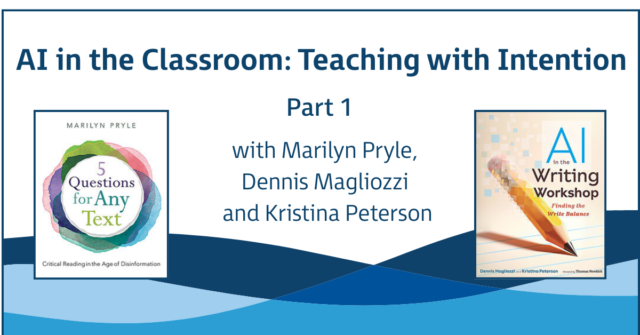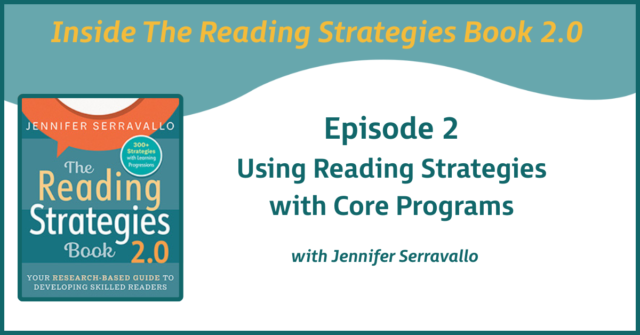
Every day students scroll past hundreds of headlines, posts, and videos. How do they know what to trust?
In 5 Questions for Any Text, educator and author Marilyn Pryle offers a practical framework to help students navigate today's media landscape with sharper, critical thinking and deeper awareness. Her approach encourages students to look beyond the surface of a text to examine its origins, its influences, its purpose, and the voices behind it.
In this first episode of this four-part series, we dive into the question of source. Who is behind a text and what might their intentions be? Marilyn shares how developing students' critical consciousness can empower them to question even texts that seem helpful or align with their beliefs.
Tune in to hear an excerpt from Marilyn's audiobook, followed by her personal reflections and a few thought-provoking questions to discuss with colleagues as you start the new year.
Transcript
Marilyn Pryle (audiobook excerpt):
Readers might think about this category by asking themselves, "Where is this text coming from? Has an organization or company sponsored it or endorsed it? Is it on a website that wants to promote a certain message? Or, how could the source of the text influence the message?" Sponsorship may be a relatively new concept for students, but it's not a difficult one. A good place to start would be by asking students about their favorite athletes and if they are aware of any sponsors for those athletes. Ask them to consider what a sponsor offers an athlete, why they would offer sponsorship, and what they might expect in return from that athlete. Give students a text, an article or social media video that clearly has been promoted, sponsored, or endorsed by another source. Examine the text together and have students identify, and then research the source. Ask, what does the source sell, promote, or believe in?
Then ask how that fits with the message of the text. The source need not have a manipulative motive. Just having students see the mutually beneficial connections between the source and text will be helpful for them both inside and outside of school. Students may conclude that a source has no ulterior or calculated motives at all. In those cases, they should feel confident in trusting the source. Let's listen to a few student reading responses for the See the Source category. Here's a response from Phoebe, a 12th grader. The article, Banned in the USA: The Growing Movement to Censor Books in Schools promotes the idea that we should not be banning books in classrooms, and that the movement of banning books is deeply undemocratic. The article starts off with some basic facts and statistics about the books that are banned, and the introduction of the facts sets the article up for an unbiased tone.
But once the fact section is over, the article begins to become more subjective towards the ideals of the company, or in this case, non-profit. The non-profit who wrote and sponsored this article is PEN America, a group that aims to protect the freedom of expression in literature and from what was featured on their About Us section seems to try and stay away from any political party affiliation. However, this does not mean the group is without bias in the section of the article, What Is a Banned Book? The article reads, quote, "PEN America defines a school book ban as any action taken against a book based on its content and as a result of parent or community challenges, administrative decisions, or in response to direct or threatened action by lawmakers or other governmental officials that leads to a previously accessible book being either completely removed from availability to students or where access to a book is restricted or diminished." End quote.
This is not the only time the company uses its own definition or statistic. Many other times in the article the phrases, "PEN America estimates" or, "based on a PEN America statistic" and others like it could be found. This allows the non-profit to tailor the article to their own liking and be more subjective towards their own ideologies by not being overtly biased and instead using facts. However, they are facts of the group's own creation and therefore not guaranteed to be accurate. In our conference, I asked Phoebe what the group could do to give their article even more credibility. I also asked her if she normally would look at a site's About Us section. She said she would not, but she realized the power of it through this RR. Now let's hear seventh-grader Brooke's response to, How to Make a TikTok: The Beginner's Guide by Jacqueline Zote.
The text looks like it is coming from Sprout Social. Sprout Social looks like a business that is making this website. TikTok is a popular thing so many people will probably read the article, and when they do, they might look into Sprout Social and support the business. The website also looks like it's promoting businesses because it says things like, quote, "Since you're creating a brand account." Unquote, which means that they're helping people to promote brands on TikTok, not make dances and other stuff like that. TikTok is a very popular app with so many people right now, and when people look up how to make a TikTok and they read this article, not only might they follow their account because it showed them how to make a TikTok, they might even buy what Sprout Social is selling or help whatever you are promoting.
I would be interested in hearing from Brooke how she detected the owner of the site, and I also wonder what Brooke's thoughts were about the purpose and audience behind each of the types of videos. Brooke insightfully pinpointed another goal of online businesses besides selling a product, gaining followers. I was interested to hear Brooke's ideas about the benefits of having followers who don't necessarily purchase anything. Conferring with students. When we're conferring with students, we always begin by responding to them personally. Students usually find this category eye-opening as Phoebe did. Phoebe later emailed, quote, "This category really helped me to take a step back from seeing what the article is telling me to asking, is this article accurate? Are the facts accurate?" End quote.
Phoebe is an avid reader and lover of books and is staunchly against book banning, but helping her see that many opinion articles have a source and thus we must examine even the ones we agree with, will help her with all texts in the future. Asking students what would make an article more credible is an effective way to help them hone their skills in evaluating texts. Brooke insightfully detected the owner of the site, a business that offered the TikTok advice. She correctly perceived that even helpful texts may have an additional business-related motive, and I would commend her awareness. Once we've responded to the student, we can work on developing critical consciousness. Here's a reminder of the importance of explicitly teaching students to analyze sources. Phoebe was a senior, a senior in high school and she had not previously considered the sources behind what she was reading. I admit I had her as a sophomore.
As we improve our efforts of preparing young people for encountering and evaluating media, we can acknowledge and build on what they already know. Once they see the connections between content and who is behind it, they will not unsee them. Using this RR category is an easy, non-threatening way to introduce this concept. Companies are becoming more and more adept at hiding their sorce-ness or sorcery. If we want a future with people who do not naively believe all media at the surface level and who can push back against the all-encompassing but sneaky pressures of big business that ultimately harm our species and the planet, we must introduce this skill at the earliest school levels. At the same time, if a source checks out, students should be able to articulate their reasons for trusting it. Many organizations produce accurate, useful content. After evaluating, students should be able to make their own judgments. Finally, here's one last question for taking the conversation further. Who is really behind this text and what do they really want?
Marilyn (commentary):
When I think about this category, I really, I think it's so important in today's world because it seems like everything we encounter in any kind of text, whether it's print or something we're viewing or something we're listening to, there's something else behind it. There's something else that is putting this text out into the world. So creating a space for students to get in the habit of asking what that is really important in our classrooms, and I don't mean to suggest that everything is nefarious, that there's something out there trying to get the students or get your money or whatever, but just helping them recognize that the polished piece that they might be looking at in class usually has something behind it. And I mean, on a very basic level, we can see this with our classroom materials, especially textbook companies and things like that, but I feel like there's an even more urgent necessity to look at this in the face of AI.
So in our classrooms and in our schools, many of our schools are embracing AI platforms that are in fact helping our pedagogy and helping to reach more students. But we have to keep asking that question, "What's the source behind this? What's the company behind this and what are they getting out of this relationship?" I think it's so important to teach students to ask that question. In this chapter, one thing I think about a lot is the student example from Phoebe. So Phoebe was my student. She was wonderful, brilliant, not afraid to ask questions. And when she wrote this RR, the fact that she mentioned in the RR, she even emailed me afterwards saying, "I never thought to ask that, what's behind what I'm reading? Or who is this group?" And in her case, it was PEN America, like, "Who are they and what is their message?"
She had never thought to ask that, and I thought, "Here's one of our smartest kids in our high school and this is just dawning on her right because of this RR exercise." So it just also made me realize that a lot of times as teachers, we assume that kids are automatically doing all these things and they're not. We have to create the space. We have to explicitly say to them, "Hey, have you thought of looking behind the curtain here or there?" So if you are discussing this in a book group, one of the things you can think about are what are your own real life examples where this has happened, where you realized a certain message or a certain article or a certain anything piece of art, whatever it is, actually was coming from someplace else?
And again, we're not trying to make the students paranoid like, the world is out to get you. But just asking that question, and even in Phoebe's case, again, the answer turned out to be something supportive and something sort of encouraging. But a lot of times that's not the case. So creating that space to just investigate is so important. And then in your book group, I would also reflect on AI. Is your school using it? Are you using it? And what is that company getting out of that relationship with you, with your students, with the school? So just to reflect on that, I think would be important.
ABOUT THE AUTHOR

Marilyn Pryle is a National Board Certified Teacher with over 25 years of experience in education. She teaches 10th grade English in Clarks Summit, PA, and is the author of several books for teachers, including 5 Questions for Any Text, Reading with Presence, and 50 Writing Activities for Meeting Higher Standards. Marilyn holds an Ed.D. in Curriculum & Instruction and was the 2020 Pennsylvania Teacher of the Year.


